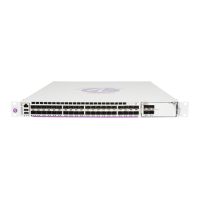Circuit Emulation VLL (Cpipe) Services
Page 154 7705 SAR OS Services Guide
Packet Payload Size
The packet payload size defines the number of octets contained in the payload of a TDM PW
packet when the packet is transmitted. Each DS0 (timeslot) in a DS1 or E1 frame contributes
1 octet to the payload, and the total number of octets contributed per frame depends on the
number of timeslots in the channel group (for example, 10 timeslots contribute 10 octets per
frame).
Jitter Buffer
A circuit emulation service uses a jitter buffer to ensure that received packets are tolerant to
packet delay variation (PDV). The selection of jitter buffer size must take into account the
size of the TDM-encapsulated packets (payload size). A properly configured jitter buffer
provides continuous play-out, thereby avoiding discards due to overruns and underruns
(packets arriving too early or too late). The maximum receive jitter buffer size is
configurable for each SAP configured for circuit emulation. The range of values is from 1 to
250 ms in increments of 1 ms.
Configuration/design Considerations
Determining the best configuration value for the jitter buffer may require some adjustments
to account for the requirements of your network, which can change PDV as nodes are added
or removed.
24 24 576 3.00 16 384 2.00
25 NA NA NA 16 400 2.00
26 NA NA NA 16 416 2.00
27 NA NA NA 16 432 2.00
28 NA NA NA 16 448 2.00
29 NA NA NA 16 464 2.00
30 NA NA NA 16 480 2.00
Table 20: Payload Size for T1 and E1 CESoPSN with CAS (Continued)
Number
of
Timeslots
T1 E1
Number of
Frames
per Packet
Payload
Size
(Octets)
Packetization
Delay (ms)
Number of
Frames
per Packet
Payload
Size
(Octets)
Packetization
Delay (ms)

